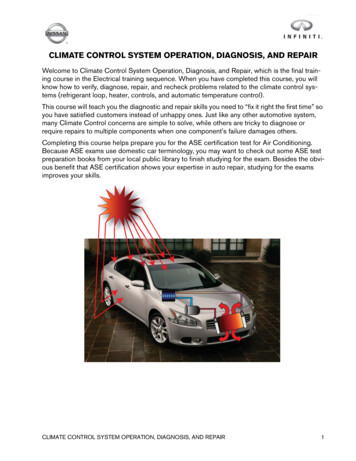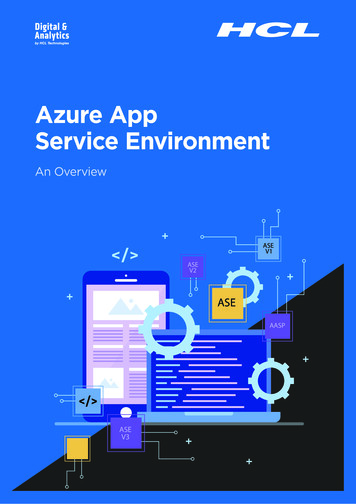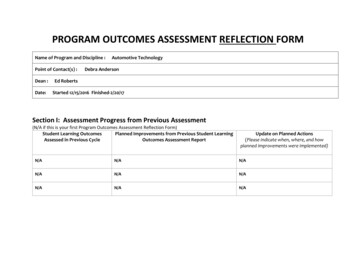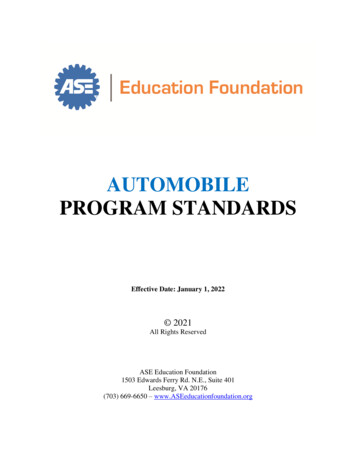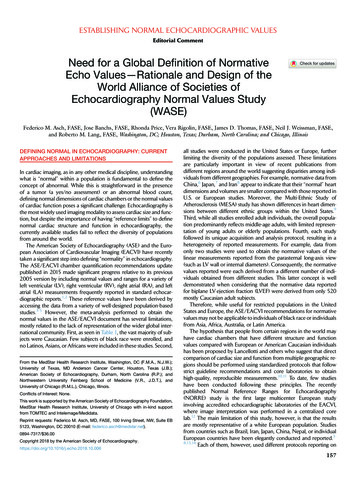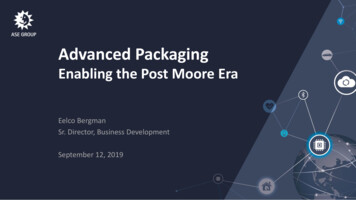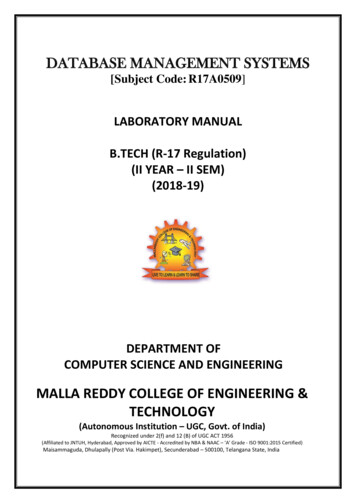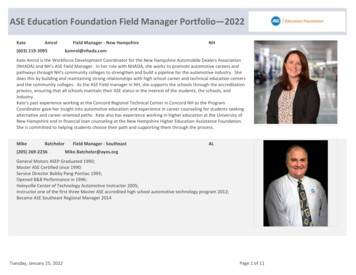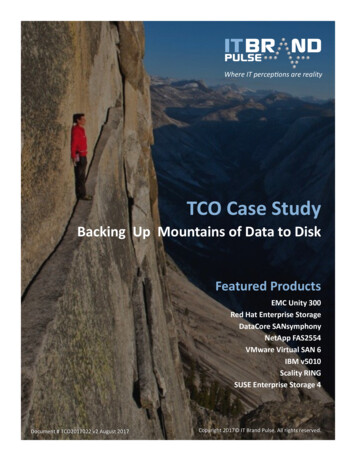
Transcription
Where IT perceptions are realityTCO Case StudyBacking Up Mountains of Data to DiskFeatured ProductsEMC Unity 300Red Hat Enterprise StorageDataCore SANsymphonyNetApp FAS2554VMware Virtual SAN 6IBM v5010Scality RINGSUSE Enterprise Storage 4Document # TCO2017022 v2 August 2017Copyright 2017 IT Brand Pulse. All rights reserved.
Catalyst For Backup to DiskThe Explosive Growth of Unstructured DataData that is neatly organized in a database management system is commonly referred to as structured data,while data that is not managed with a database is often referred to as unstructured data. Data storagepriorities are being changed by billions of new internet connected device such as sensors, watches,smartphones, and cameras, which are spewing trillions of unstructured data files.Although the unstructured data is hardly ever accessed, if at all, an offline backup copy is not good enough.The data must be stored online because it is grist for the mill of big data analytics engines inside today’sbusiness intelligence applications and tomorrow’s machine learning applications. The result is ITorganizations are using backup software to ship mountains of cold data to online archives. The priority forapplication environments using unstructured data is to minimize storage costs while meeting the growth inrequirements for capacity.The Growth of Unstructured Data & Requirement for Online ArchiveUnstructured Data—The priority for storage islowering costs for infrequently accessed dataStructured Data—The priority for storage is highestperformance for frequently accessed dataDocument # TCO2017022 v2, August 2017Page 2 of 15
The New Business of BackupStoring ALL Data for AnalyticsAs big data analytics become a common component of business intelligence applications, analytics vendorsare asking customers to store ALL their data in order to get the best results from their analytics engines.As a result, the business of “backup” software vendors has changed to “data management.” Products fromvendors such as Commvault, Dell EMC, HPE, Veeam and Veritas are aiming to track all the data in anenterprise, the applications that are using it, where it came from, where it’s going, and who is accessing it.The role of core backup applications has expanded to managing ALL the data in an enterprise, and therequirement for backup-to-disk is growing because real-time analytics needs the data to be online.Looking forward, even small and medium will be trending towards storing ALL of their data online in order toleverage analytics capability that will exist in every business intelligence application.Modern Business Intelligence & Data Storage ArchitectureAnalytics are allowing business intelligence applications to react to customer’s browsing activity in real-time, and to predict theiractions based on past behavior. The more data available to the analytics engine, the better the results. That’s why enterprises arelooking towards storing ALL data, and using backup-to-disk software as the tool for moving the data.Document # TCO2017022 v2, August 2017Page 3 of 15
Backup-to-Software Defined StorageBased on Industry Standard Servers & SoftwareAll major data management and protection vendors have the ability to backup data from application serversto disk arrays. What’s relatively new is the ability to backup data to software defined storage based onindustry standard servers and object software defined storage. The new generations of solutions are far moreopen and scalable than previous generations of backup-to-disk solutions based on SAN storage. This casestudy will reveal if backup-to-software defined storage is more cost-effective.Backup to Disk with Software Defined StorageThe software defined solutions evaluated in this report incorporate an architecture which uses object storage and industry standard servers.The solution shown above uses SUSE Enterprise Storage OSD and monitor nodes running on HPE industry standard servers.Document # TCO2017022 v2, August 2017Page 4 of 15
The Disk Storage SystemsDisk Arrays and Software-Defined StorageThis report examines three disk array systems and five software-defined storage systems, including serverhardware needed for hosting the software defined storage applications.Entry-level disk arrays were utilized because they met the performance, availability and useable capacityrequirements of the backup to disk application evaluated in this report. If performance-oriented mid-range orhigh-end storage arrays were used instead, the five-year TCO would have been significantly higher.Dozens of features could have been added to all the configurations to enhance the performance (SSD),availability (replication) and useable capacity (compression and dedup). But a simple storage configurationmet our report’s requirements for bulk storage, which is infrequently accessed.SolutionTypeEMC Unity 300Disk ArrayNetApp FAS2554Disk ArrayIBM v5010Disk Array(appx. 600TB after 5 years)DataCore SANsymphonySoftware-Defined StorageFully redundantRed Hat Enterprise StorageSoftware-Defined StorageOn-site service/next business dayVMware Virtual SAN 6Software-Defined StorageCost of raw storageScality RINGSoftware-Defined Storage(no compression, dedup, etc.)SUSE Enterprise Storage 4Software-Defined StorageDocument # TCO2017022 v2, August 2017ConfigurationsStarting at 250TBGrowing at 25% per yearIncludes server hardware for SDSPage 5 of 15
DataCore SANsymphonyDataCore’s Flagship ProductSANsymphony software is powered by DataCore Parallel I/O technology, and is the company’s flagshipproduct. It maximizes IT infrastructure performance, availability and utilization by virtualizing storagehardware.HighlightsSANsymphony software runs on standard x86 servers, providing one set of common storage services acrossall storage devices under its control. The combined storage capacity of the different devices is managed asshared pools to eliminate wasted space.Why it Wasn’t the Lowest Cost SolutionDataCore software is offers industry-leading performance for database/transaction processing workloads,and is priced accordingly. The storage capacity-based licenses add-up over the 5-year period to makeSANsymphony the 4th most expensive solution we looked at.Five-Year Cost of Ownership: 245,824Document # TCO2017022 v2, August 2017Page 6 of 15
Dell EMC Unity 300Dell EMC’s Most Affordable Unified, Hybrid Storage Array is Flat-Out ExpensiveDell EMC recommended the Unity 300 as a disk backup target because it’s the most affordable unified, hybridstorage array available from the company. The system can support 150 HDDs and up to 900TB of rawcapacity using 6TB HDDs. Add-on disk array enclosures support up to 15 of the 3.5” 6TB drives.HighlightsUnity hybrid storage systems support block, file, and VMware VVols, as well as native NAS, iSCSI, and FibreChannel protocols. Unity includes automated data lifecycle management to lower costs, inline compression,built-in encryption, local point-in-time copies and remote replication, data-in-place conversions, and deepecosystem integration with VMware and Microsoft.Why it Wasn’t the Lowest Cost SolutionThe Unity 300 may be Dell EMC’s most affordable array, but that is like saying the C-Class is Mercedes's mostaffordable car starting at 40,000. In addition, this system is not optimized for bulk storage. You can scale butwith only fifteen 6TB drives per chassis, this results in the need for at least 1 new chassis every year.Five-Year Cost of Ownership: 330,865Document # TCO2017022 v2, August 2017Page 7 of 15
Red Hat Ceph StorageSoftware that Scales; Pricing that Doesn’tRed Hat Enterprise Ceph Storage is designed to scale effortlessly and cost-effectively by adding x86 servernodes as needed. The object storage architecture is optimized for capacity over performance which is perfectfor this report’s disk backup requirement. However, the product is priced at a premium which makes itdifficult to scale from a cost standpoint.HighlightsRed Hat Ceph Storage is a self-healing, self-managing platform with no single point of failure. The softwaremanages data on a single distributed computer cluster and provides interfaces for object and block storage.In the future, the software will include an interface for file storage.Why it Wasn’t the Lowest Cost SolutionThe low-cost hardware foundation used for Red Hat Ceph Storage is exactly the same as the configurationused for other software-defined storage solutions in this analysis. The result of the capacity-based softwarepricing model is the second most expensive solution for disk backup.Five-Year Cost of Ownership: 328,847Document # TCO2017022 v2, August 2017Page 8 of 15
VMware Virtual SANTightest Integration with vSphereVMware vSphere is at the center of data center architectures for many IT organizations. That’s why serveradmins prefer infrastructure which is tightly integrated with their hypervisor. The good news is Virtual SANoffers the strongest integration with vSphere. The bad news is cost of support more than doubles the price.HighlightsVirtual SAN delivers flash-optimized, high-performance storage for hyper-converged infrastructure. Itleverages commodity x86 components and integration with VMware vSphere, as well as the entire VMwarestack, to form a simple storage platform for virtual machines.Why it is the Lowest Cost SolutionIf support was included in the price of the software license—like it is with some other software-definedstorage products—Virtual SAN would scale cost effectively. But it’s not; and the result is the cost of supportexceeds the cost of the base product over a five year period.Five-Year Cost of Ownership: 258,151Document # TCO2017022 v2, August 2017Page 9 of 15
NetApp FAS2554Mid-Range System; High-End CostNetApp recommended the FAS2554 for disk backup because it’s designed for higher capacities. It is targetedat midsize organizations and distributed sites of larger organizations, Windows applications and virtual serverconsolidation with multiple workloads, and for customers who require cost-effective larger capacity.HighlightsThe NetApp FAS2554 has a capacity of 1.1PB and 144 HDDs packaged in high-density drive enclosuressupporting up to twenty four, 3.5” drives. The flexible system supports iSCSI, NFS, pNFS, and CIFS/SMBstorage protocols.Why it Wasn’t the Lowest Cost SolutionNetApp FAS2554 gets top marks for ease-of-use and for offering high-density configurations which shouldmake scaling disk backup cost effective. But customers are asked to pay a hefty premium for the NetAppbrand. For example, add-on 8TB drives for a NetApp FAS2554 can run well over 2,000 — over four times thecost of add-on drives for industry-standard servers supporting software-defined storage.Five-Year Cost of Ownership: 211,534Document # TCO2017022 v2, August 2017Page 10 of 15
IBM v5010The Lowest Cost Disk Array Solution We EvaluatedThe IBM Storwize v5010 is a hybrid block storage system capable of being deployed with HDDs, SSDs, or acombination of both. Although the packaging is not high-density, the system is feature-rich and aggressivelypriced.HighlightsThe Storwize v5010 base unit supports iSCSI host connectivity, with options to add 16GB Fibre Channel, 12GbSAS, and 10GbE iSCSI/FCoE, and up to 10 expansion enclosures for a maximum of 264 drives. The 2Ucontrollers and expansion enclosures hold twelve 3.5-inch drives. Other key features include thinprovisioning, FlashCopy, Easy Tier, and remote mirroring.Why it Wasn’t the Lowest Cost SolutionIf disk backup needed the additional features rolled into the v5010, this product might represent the bestvalue for the money. But for our specification—which requires the most capacity for the lowest cost—software-defined storage solutions are the ones to beat.Five-Year Cost of Ownership: 195,458Document # TCO2017022 v2, August 2017Page 11 of 15
Scality RINGFrom a Pioneer in Software-Defined StorageScality delivers web-scale storage that has been available since 2009. The Scality RING (its software-definedstorage) turns commodity x86 servers into a disk backup pool for file and object storage at petabyte scale.HighlightsThe Scality RING is an attractive alternative to tape for long-term archives with much lower latency.Leveraging any standard servers at the cost and density of your choice, the Scality RING enables ITorganizations to deploy self-healing archives that grow to petabytes.Why it Wasn’t the Lowest Cost SolutionThe solution from Scality is the second, best-priced solution we examined. The difference between Scality,and price leader SUSE, was the cost of support. It’s also worth noting the cost of Scality software is entirelyfront loaded, while the cost of SUSE software is spread out evenly over the five-year period.Five-Year Cost of Ownership: 193,384Document # TCO2017022 v2, August 2017Page 12 of 15
SUSE Enterprise Storage 4First CEPH Storage to Offer CephFSSUSE’s newest version of software-defined storage—SUSE Enterprise Storage 4 —is a comprehensive storagesolution best suited for “Large Data” applications like disk backup Its scale-out architecture allows customersto simplify their environment, while providing limitless storage capacity for large data file applications such asvideo surveillance, CCTV, online presence, streaming media, medical (x-rays, mammography, CT, MRI),seismic processing, genomic mapping, CAD and backup datasets.HighlightsSUSE Enterprise Storage 4 (SES 4, for short) includes the industry’s first production-ready version of CephFS.By adding much-anticipated native filesystem access, SES 4 allows customers to deploy a unified block, objectand file storage environment to reduce the capital and operational costs of their storage infrastructure.Why it is the Lowest Cost SolutionSUSE offers several layers of cost savings to enterprise storage IT professionals. The foundation is industrystandard hardware. Layered on top, is storage software with comparatively low annual license fees spreadout over the life of your storage. Finally, support is included in the cost of the software license. Forapplications generating a lot of data, SUSE Enterprise Storage 4 scales capacity but not cost.Five-Year Cost of Ownership: 149,408Document # TCO2017022 v2, August 2017Page 13 of 15
Side-by-Side ComparisonBackup to Software-Defined Storage Eliminates Branded Storage TaxesIT organizations have shown a strong preference for branded storage. Everyone knows they’re paying a tax forthe EMC or NetApp logo, but because they deployed the “Mercedes of storage arrays”, they also figure theywon’t get fired when something goes wrong. This branded storage tax is applied to every disk drive acustomer purchases during the life of the system, and is as much as 4x the cost of HDDs used in industrystandard servers and software-defined storage systems.SUSEEMCNetAppIBMHPDrive Capacity10TB6TB8TB8TB8TBDrive Price 699 2,500 3,000 1,400 2,800Cost/GB .070 .417 .375 .175 .350Cumulative Five-Year Cost of 250TB Growing at 25% Per YearThe chart below shows a side-by-side comparison of eight disk backup solutions based on pricing provided bythe manufacturers or their channel partners. Surprisingly, 2 of the 3 most expensive solutions were SDSproducts (not surprisingly from traditional enterprise vendors), while the clear price leader for this class ofsolution was SUSE Enterprise Storage 4.Note: On Year 1, all systems were approximately 250TB, except for HP and NetApp systems which started at 190TB.Document # TCO2017022 v2, August 2017Page 14 of 15
The Bottom LineThe Future is Software-Defined StorageThe data in this report indicates that traditional enterprise storage is under tremendous price pressure fromsoftware-defined storage available from vendors like SUSE, especially for capacity-driven solutions such asdisk backup.This report also reveals that Red Hat and VMware are positioning the price of their software-defined storageofferings at parity with traditional (expensive) enterprise storage solutions.The bottom line? IT organizations looking to lower the cost of disk backup should evaluate software-definedstorage solutions. Based on easy-to-service x86 servers, the technology is proven by hyperscale public cloudproviders and can be deployed in private clouds for 1/3 the cost of branded storage.Related LinksTotal Cost of Ownership WikiDataCore SANsymphony Product InfoDell EMC Unity 300 Product InfoIBM Storwize v5010Product InfoNetApp FAS2554 Product InfoVMware Virtual SAN Product InfoRed Hat CEPH Storage Product InfoScality RING Product InfoSUSE Enterprise Storage Product InfoIT Brand PulseAbout theAuthorFrank Berry is founder and senior analyst for IT Brand Pulse, a trusted source of dataand analysis about IT infrastructure, including servers, storage and networking. Asformer vice president of product marketing and corporate marketing for QLogic, andvice president of worldwide marketing for the automated tape library (ATL) division ofQuantum, Mr. Berry has over 30 years experience in the development and marketingof IT infrastructure. If you have any questions or comments about this report, contactfrank.berry@itbrandpulse.com.Document # TCO2017022 v2, August 2017Page 15 of 15
TCO Case StudiesTCO Case StudiesIT professionals know the cost of owning servers, networking and storage equipment is more than thepurchase price of the hardware. The total cost of IT equipment also includes installation, software licenses,service, support, training, upgrades, and other costs related to a specific product or situation.TCO case studies are designed to provide busy IT Pros with vendor-independent data about the total cost ofspecific products. This case study examines eight comparably-equipped enterprise storage solutions: fourfrom various disk array vendors, and four from software-defined storage vendors. It turns out one of thevendors stands-out with lower TCO based on industry standard hardware and attractively priced softwarelicenses with support included.Read the rest of this report to find out who it is. Hint: It isn’t VMware!Cost ComponentsBelow are the components used to calculate the total cost of owning mass storage over a five-year period:Hardware Product Cost - The purchase price for storage array chassis, servers and HDDs.Recurring Software License Fees - Annual license fees for software, if applicable.Recurring Annual Service & Support Fees - The cost of a service agreement providing on-site service and spareparts, with next business day response time.Training - The cost of certifying one network engineer for this class of product (not applicable in this report).Spare Parts - The cost of on-site spare power supplies and SFPs (not applicable in this report).Total Cost of Ownership - The sum of the hardware product cost, software license fees, service and supportfees, training, and spare parts over a five-year period.Getting the Cost DataThe product pricing (cost) data used in this case study comes from on-line resellers and solution providerswho responded to a request for quote (RFQ) from IT Brand Pulse.Apples-to-Apples ComparisonThe hardware, software and service products used in this case study were selected based on comparability toone other. Differences in the products and services are described in the product overviews.Document # TCO2017022 v2, August 2017Page 16 of 15
industry standard servers and object software defined storage. The new generations of solutions are far more open and scalable than previous generations of backup-to-disk solutions based on SAN storage. This case study will reveal if backup-to-software defined storage is more cost-effective. ackup to Disk with Software Defined Storage
